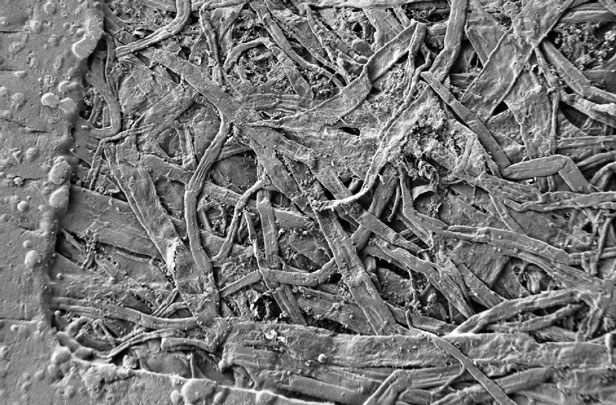
Source: “Toner-print removal from paper by long and ultrashort pulsed lasers”
David Ricardo Leal-Ayala et al.
Proceedings of the Royal Society A, published online March 14, 2012
RESULTS: Researchers at the University of Cambridge removed ink from laser-printed sheets of paper using laser light. The process is so gentle that a single sheet of paper can be used five times before it requires conventional recycling.
WHY IT MATTERS: Recycling paper, which involves breaking it down and re-forming it, uses a lot of energy and water. The researchers calculate that removing ink with their process releases no more than half as much carbon dioxide as recycling a sheet of paper, and it doesn’t require any water.
METHODS: Heat is used to affix toner to paper, and the new process uses heat to remove it. The challenge was finding a way to apply the heat only to the toner, to avoid damaging the paper. The researchers selected green laser light, because dark toner absorbs it and heats up while the light reflects off the white paper. They used
short pulses of light that vaporize the toner before it has a chance to transfer heat to the paper and destroy it.
NEXT STEPS: The researchers are looking for ways to decrease the cost of the process by about 10 percent so that the technology will be economically competitive with recycling.
Efficient Apps
A new tool reveals how mobile apps waste your battery life and what to do about it
Source: “Fine Grained Energy Accounting on Smartphones with Eprof”
Abhinav Pathak et al.
EuroSys 2012, Bern, Switzerland,
April 10–13, 2012
RESULTS: Many smart-phone apps use more energy than they need to, researchers at Purdue University and Microsoft Research found. Software tools that they developed can identify where energy is being wasted and help developers reduce the energy consumption of their apps. They used the system to reduce energy use in four apps by 20 to 65 percent.
WHY IT MATTERS: Mobile operating systems are designed to be as energy efficient as possible, but the developers of apps that run on those systems generally don’t work with energy consumption in mind. The researchers’ tools could make smart phones more useful by decreasing unnecessary drains on the battery.
METHODS: The researchers created a system that logs everything mobile apps do, such as accessing the camera or using the network connection to transfer data. Then it determines the total energy consumption of these actions and creates a summary of each app’s most energy-demanding processes. That summary makes clear which parts of an app need altering to reduce energy use.
NEXT STEPS: The researchers are developing tools to automatically fix code that leads to excess energy use. Their system could also be built into smart-phone operating systems so that apps could be forced to use less energy.
Keep Reading
Most Popular
Large language models can do jaw-dropping things. But nobody knows exactly why.
And that's a problem. Figuring it out is one of the biggest scientific puzzles of our time and a crucial step towards controlling more powerful future models.
How scientists traced a mysterious covid case back to six toilets
When wastewater surveillance turns into a hunt for a single infected individual, the ethics get tricky.
The problem with plug-in hybrids? Their drivers.
Plug-in hybrids are often sold as a transition to EVs, but new data from Europe shows we’re still underestimating the emissions they produce.
Google DeepMind’s new generative model makes Super Mario–like games from scratch
Genie learns how to control games by watching hours and hours of video. It could help train next-gen robots too.
Stay connected
Get the latest updates from
MIT Technology Review
Discover special offers, top stories, upcoming events, and more.